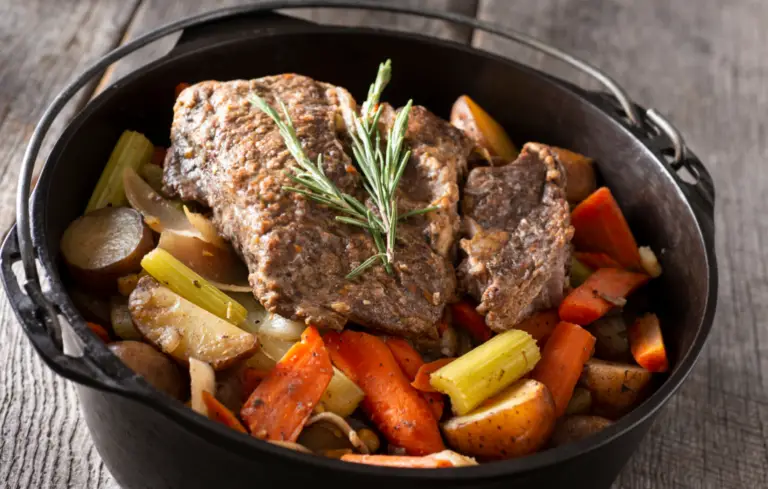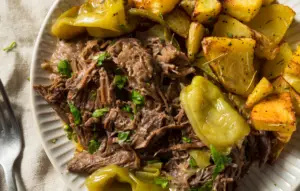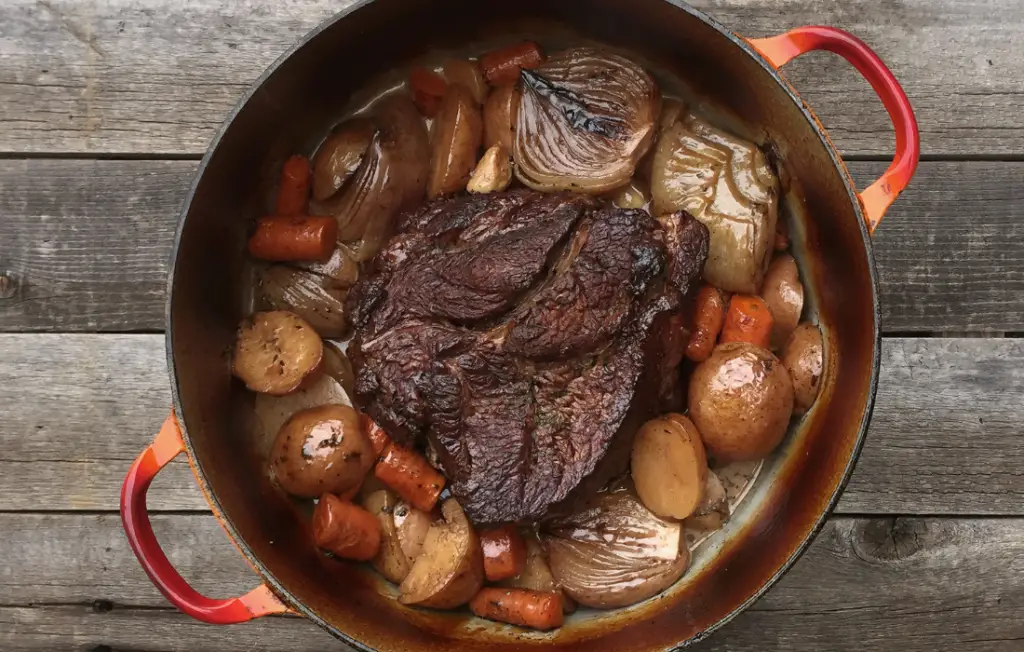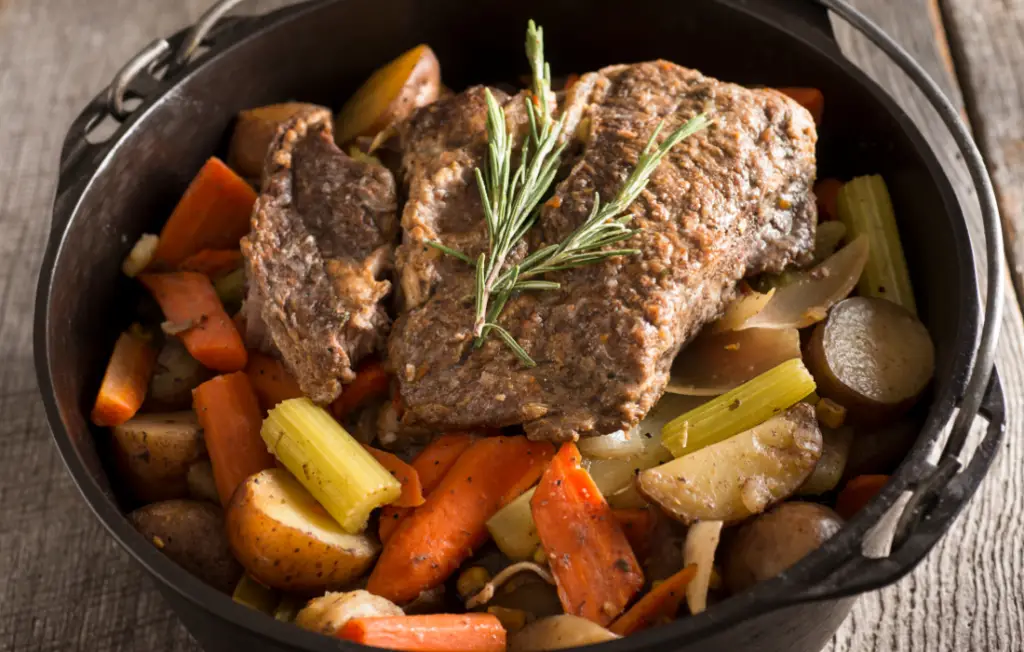Ever tried to prepare a mouth-watering pot roast in a Dutch oven, only to end up with a dish as tough as old boots? Isn’t it quite the letdown when you’ve spent hours anticipating a succulent, fall-apart roast, but what you get is far from it?
To prevent tough pot roast in a Dutch oven, start by selecting a high-quality, fatty cut of meat like a chuck roast. Next, season and brown your meat on all sides to lock in the flavors. Finally, cook your roast low and slow – a temperature of about 325 degrees Fahrenheit for around 3-4 hours should result in a tender, juicy roast.
In this article, we’ll journey together into the world of Dutch oven cooking, specifically focusing on preventing tough pot roast. By exploring expert tips, addressing common pitfalls, and even venturing into wine pairings, we aim to equip you with all the necessary tools to create a pot roast that’s not only tender but also brimming with flavor. Get ready to impress at your next family gathering or simply make your weekday meal a gourmet experience.

Easy Pot Roast Recipe
This easy Dutch oven pot roast recipe gives you tender, flavorful meat every time. With simple ingredients and straightforward steps, you’ll create a delectable dish that’s sure to impress.
- Total Time: 4 hours
- Yield: 6 servings 1x
Ingredients
- 3–4 pounds chuck roast
- Salt and pepper to taste
- 2 tablespoons olive oil
- 1 large onion, chopped
- 3 cloves garlic, minced
- 2 cups beef broth
- 2 tablespoons Worcestershire sauce
- 4 carrots, cut into chunks
- 4 potatoes, cut into chunks
- Fresh rosemary and thyme sprigs
Instructions
- Season the chuck roast with salt and pepper.
- Heat the Dutch oven over medium-high heat, add olive oil, and brown the roast on all sides.
- Remove the roast and set aside. In the same pot, add the chopped onion and minced garlic, cooking until softened.
- Add beef broth and Worcestershire sauce, scraping the bottom of the pot to release any stuck bits.
- Return the roast to the pot, add carrots, potatoes, and fresh herbs.
- Cover the Dutch oven and bake at 325°F for 3-4 hours, or until the roast is tender.

Notes
Adjust the cooking time depending on the size of your roast. Remember, low and slow is the key to a tender pot roast.
- Prep Time: 20 minutes
- Cook Time: 4 hours
- Category: Main Course
- Method: Dutch Oven
- Cuisine: American
- Diet: Gluten Free
Understanding Why Pot Roast Gets Tough
Ever find yourself asking, “Why is my pot roast tough?” It’s a common kitchen mystery. At its core, pot roast toughness boils down to a simple science. Pot roasts are typically made from tougher cuts of beef, like the chuck or round cut. These cuts are rich in connective tissues, including collagen, which can make the meat tough if not cooked properly. Overcooking or cooking at too high a temperature can also cause the meat fibers to contract and lose moisture, resulting in a dry, tough roast. On the flip side, undercooking doesn’t allow enough time for the collagen to break down and tenderize the meat. So, achieving the right balance in your cooking process is key to a tender, flavorful pot roast.
Expert Insights
No one wants a pot roast that requires a chainsaw to cut, right? So, here are some tips from professional chefs to avoid that tough pot roast debacle.
Firstly, don’t skimp on browning your meat. It’s not just about the lovely color; it’s about sealing in those flavors and creating a base for a delicious gravy.

Secondly, remember the mantra of pot roast cooking – low and slow. Patience is your best friend when cooking a pot roast. Slow cooking at a lower temperature allows the collagen in the meat to break down into gelatin, transforming your tough cut into a tender, juicy delight.
Lastly, let your roast rest after cooking. It may be hard to resist digging in right away, but trust me, it’s worth the wait. Resting allows the juices to redistribute throughout the roast, keeping it moist and flavorful. Remember, folks, good things come to those who wait!
Seasonal Variations
Let’s not leave our pot roast hanging out in the cold (or heat)! Adapting your pot roast recipe to the seasons can bring a refreshing twist to this classic dish. In the summer, lighten up your pot roast with a splash of white wine and fresh herbs like basil or cilantro. Throw in some summer veggies like zucchini or bell peppers for a colorful touch. When fall rolls around, give your roast an autumnal makeover with root vegetables and a hint of apple cider. Winter calls for hearty, comforting flavors – think stout beer, rosemary, and chunky root vegetables. And as for spring, add some brightness with fresh peas, carrots, and a squeeze of lemon.
Dietary Adaptations
Whether you’re feeding a crowd with varied dietary needs or exploring new ways to enjoy your pot roast, there are several ways you can adapt this recipe. For a gluten-free version, make sure to use a gluten-free beef broth. For a lower sodium option, opt for a low-sodium beef broth and go easy on the added salt. If you’re catering to a paleo diet, simply skip the potatoes and add more paleo-friendly veggies like carrots and Brussels sprouts.
Troubleshooting Tips for Tough Pot Roast
Even the best of us can stumble upon a tough roast now and then. But don’t worry, I’ve got your back! Here are some common issues and how to fix them:
- If your pot roast is tough and chewy, it may be undercooked. The solution? Patience, my friend. Allow it more time to cook and let that collagen work its magic.
- If your roast is dry, it might be overcooked. To fix this, try reducing the cooking time and ensure you have enough liquid in your Dutch oven.
- If your roast lacks flavor, remember to season well before browning, and don’t forget to deglaze your pan to capture all those tasty bits!
Wine Pairing with Pot Roast
Ah, wine – pot roast’s partner in crime. A good rule of thumb when pairing wine with pot roast is to match the intensity of the dish. Since pot roast is a hearty, flavorful dish, it pairs well with full-bodied red wines. A Cabernet Sauvignon with its bold flavors and high tannin content can hold up to the rich taste of the pot roast. Alternatively, a Merlot or Zinfandel, with their red fruit flavors and lower tannin, can also complement the dish well. But remember, the best wine is the one you enjoy drinking, so pick what tickles your palate!
| Wine | Characteristics | Why it Works |
|---|---|---|
| Cabernet Sauvignon | Full-bodied, high in tannins, flavors of dark fruit and spices | The bold flavors and high tannins of Cabernet Sauvignon can stand up to the rich taste of the pot roast. |
| Merlot | Medium-bodied, lower tannins, flavors of red fruits and herbs | Merlot’s softer tannins and fruity flavor profile complement the savory, hearty pot roast without overwhelming it. |
| Zinfandel | Full-bodied, medium tannins, flavors of jammy fruits and spices | Zinfandel’s bold fruit flavors and spice notes match well with the richness of the pot roast, enhancing its savory characteristics. |
| Syrah/Shiraz | Full-bodied, high tannins, flavors of dark fruits, pepper, and spices | Syrah’s robust flavors and spicy notes make it a great match for a flavorful pot roast. |
| Pinot Noir | Light to medium-bodied, lower tannins, flavors of red fruits, earthy notes | Pinot Noir’s lighter body and earthy flavors can provide a nice contrast to a rich pot roast, especially if the dish includes root vegetables. |
FAQ about Dutch Oven Pot Roast
Now, let’s tackle some common queries that might be circling around in your mind about this culinary masterpiece, the Dutch oven pot roast.

Can You Overcook Pot Roast in Dutch Oven?
Yes, indeed! Just like the 90’s fashion trends, it is possible to overdo it. Overcooking your pot roast in a Dutch oven can lead to dry, tough meat. Remember, pot roast loves a low and slow approach. Typically, a pot roast cooked in a Dutch oven at 325°F (165°C) will need about 2-3 hours to become tender. But remember, cooking times can vary based on the size and cut of the meat, so it’s always a good idea to check for tenderness as you go along.
How to Clean a Dutch Oven?
Cleaning a Dutch oven? It’s less of a chore than you might think! Here are some tips:
- Allow your Dutch oven to cool down before cleaning. Plunging a hot Dutch oven into cold water might lead to thermal shock, causing it to crack. We don’t want that!
- Use warm water and mild dish soap for cleaning. A non-abrasive sponge or brush will be your best friend here.
- Avoid using metal utensils or abrasive cleaners as they can scratch the enamel surface.
- Dry thoroughly before storing. You can also pop it in a warm oven to dry completely. This helps prevent rusting.
Remember, a well-cared-for Dutch oven can be a faithful cooking companion for years to come!
Conclusion
Well, there you have it folks – your guide to achieving that mouth-watering, fall-apart tender pot roast in a Dutch oven, without a hint of toughness. We’ve delved into the why’s and how’s, shared expert insights, and even thrown in some wine pairing suggestions for that perfect dining experience. Remember, good cooking is as much about the journey as it is about the destination. So, don your apron, roll up those sleeves, and let’s make that roast!
Whether you’re a seasoned home cook or a novice in the kitchen, don’t be afraid to experiment with your pot roast. Add your unique twist, adjust to your dietary needs, and most importantly, have fun in the process! After all, as they say in the Bahamas, “if it tastes good, it’s good!”
Now, with this treasure trove of information and my trusty Dutch oven, I am off to create some pot roast magic. Care to join me? Let’s get toasted and roasted!


